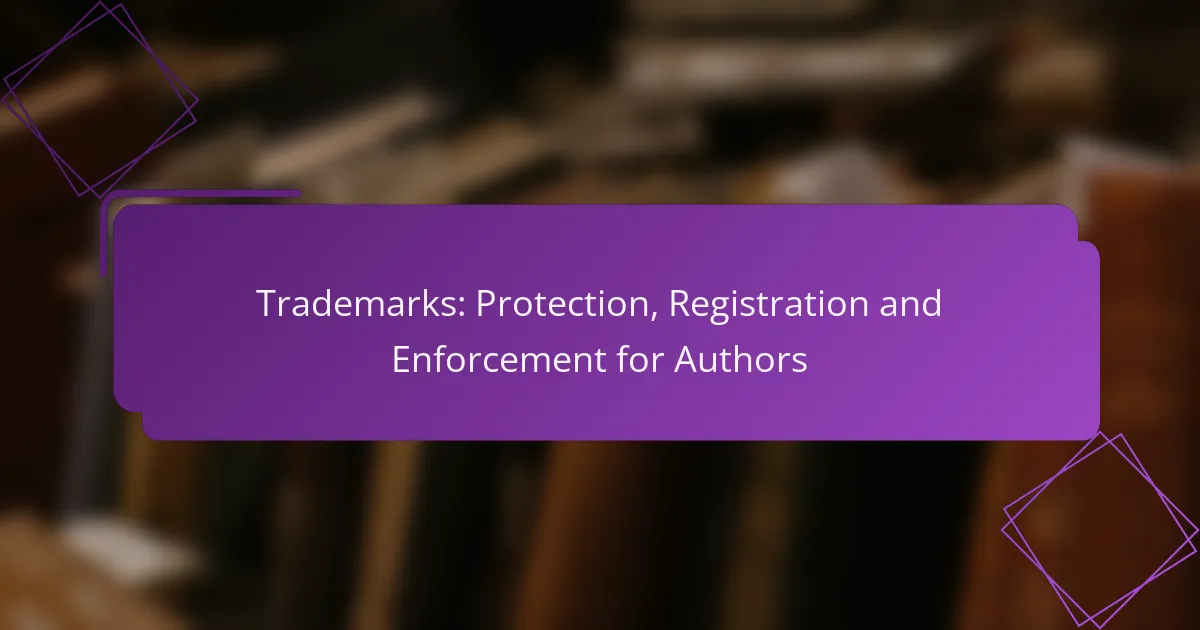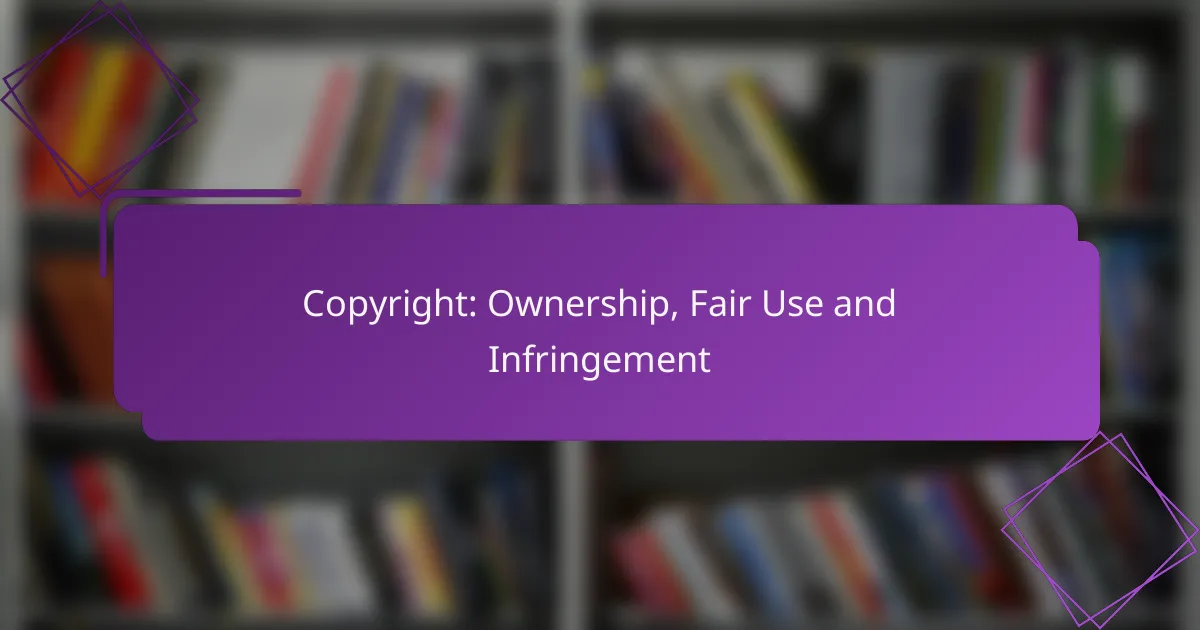Authors can safeguard their creative works by registering trademarks with the United States Patent and Trademark Office (USPTO) and leveraging common law rights. This combination not only secures exclusive rights but also offers a pathway for legal recourse in cases of infringement. The registration process involves submitting an application and necessary documentation to validate the trademark, with costs varying based on jurisdiction and application complexity.
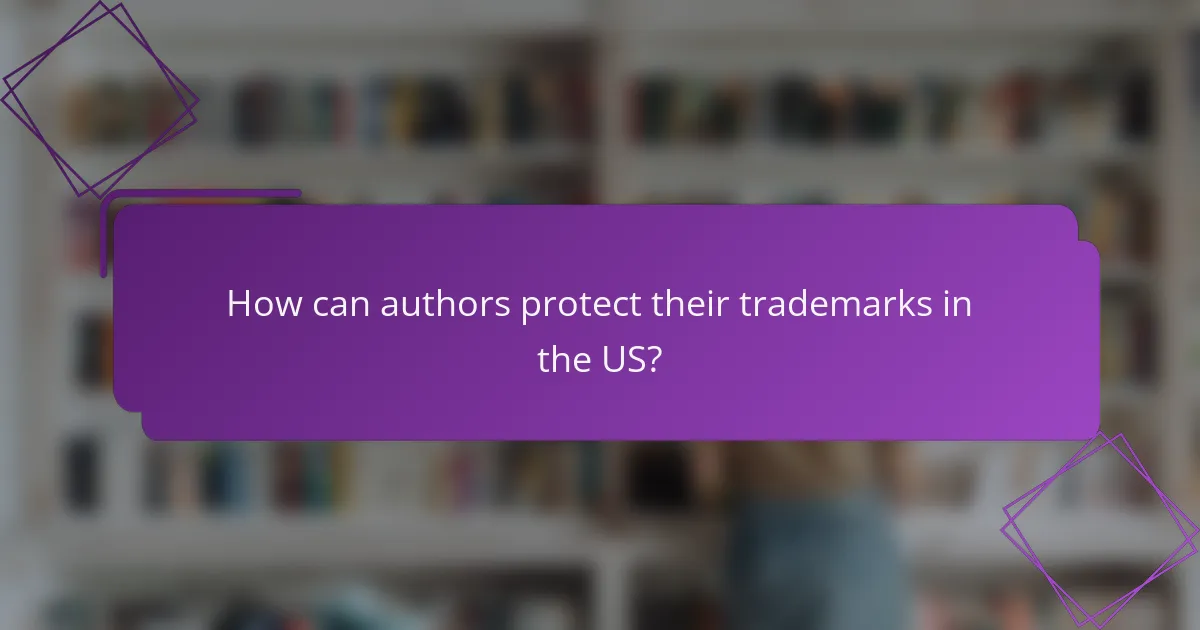
How can authors protect their trademarks in the US?
Authors can protect their trademarks in the US by registering them with the United States Patent and Trademark Office (USPTO) and utilizing common law rights. This dual approach helps secure exclusive rights and provides legal recourse against infringement.
Filing a trademark application
To file a trademark application, authors should first conduct a thorough search to ensure their desired trademark is not already in use. Once confirmed, they can submit their application to the USPTO, which includes details about the trademark, its intended use, and the associated goods or services.
The application process typically takes several months, and authors should be prepared to respond to any inquiries from the USPTO. Fees for filing can range from a few hundred to over a thousand dollars, depending on the application type and the number of classes of goods or services included.
Using common law rights
Common law rights arise automatically when an author begins using a trademark in commerce, even without formal registration. These rights can provide some level of protection against infringement, particularly within the geographic area where the trademark is used.
However, common law rights are limited compared to registered trademarks. Authors should document their use of the trademark, including dates and contexts, to strengthen their claim in case of disputes.
Monitoring for infringement
Authors must actively monitor the marketplace for potential trademark infringement to protect their rights. This can involve regular searches of online platforms, social media, and trademark databases to identify unauthorized use of their trademarks.
If infringement is detected, authors should consider sending a cease-and-desist letter to the offending party. In some cases, legal action may be necessary to enforce their rights, so maintaining accurate records of trademark use and any infringement instances is crucial.
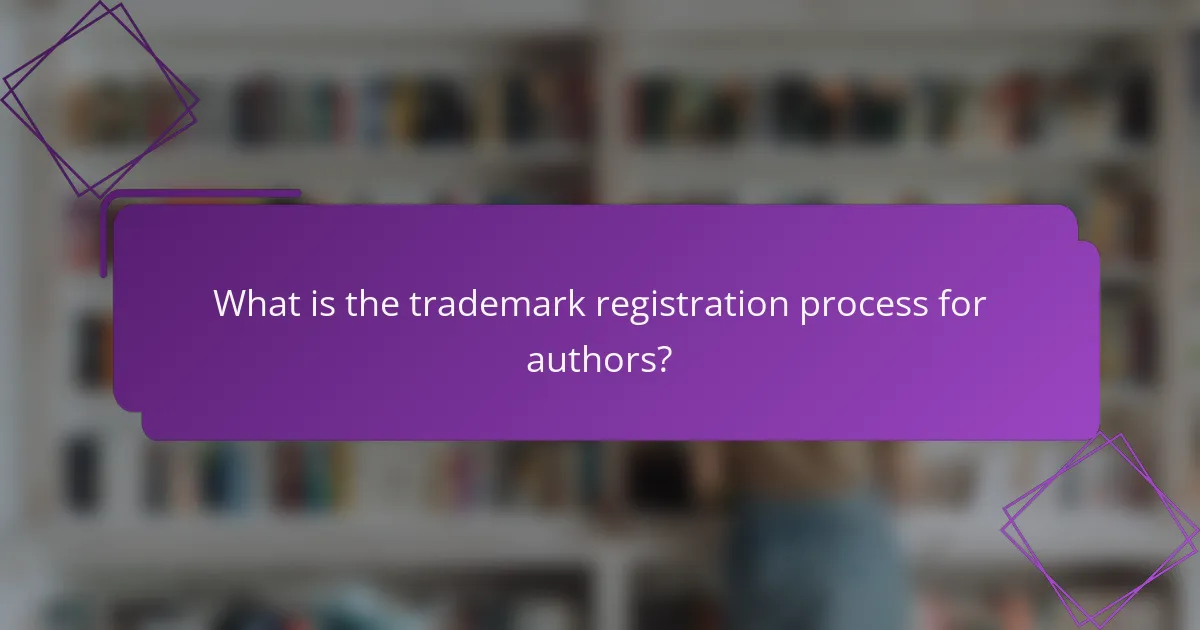
What is the trademark registration process for authors?
The trademark registration process for authors involves several key steps to secure legal protection for their unique works or brands. This process typically includes submitting an application to the United States Patent and Trademark Office (USPTO) and providing necessary documentation to establish the trademark’s validity.
Steps to register with the USPTO
To register a trademark with the USPTO, authors should first conduct a thorough search to ensure their desired trademark is not already in use. This can be done using the USPTO’s Trademark Electronic Search System (TESS).
Once the search is complete, authors can file an application online through the Trademark Electronic Application System (TEAS). The application requires details about the trademark, including its description and intended use, along with the appropriate filing fee, which can range from a few hundred to over a thousand USD depending on the application type.
Required documentation for registration
Authors must provide specific documentation when applying for trademark registration. This includes a clear representation of the trademark, a description of the goods or services associated with it, and proof of its use in commerce, if applicable.
Additionally, authors should prepare to submit a specimen showing the trademark as it is used in the marketplace. This could be a label, packaging, or advertisement that features the trademark. Ensuring all documentation is accurate and complete can help avoid delays in the registration process.
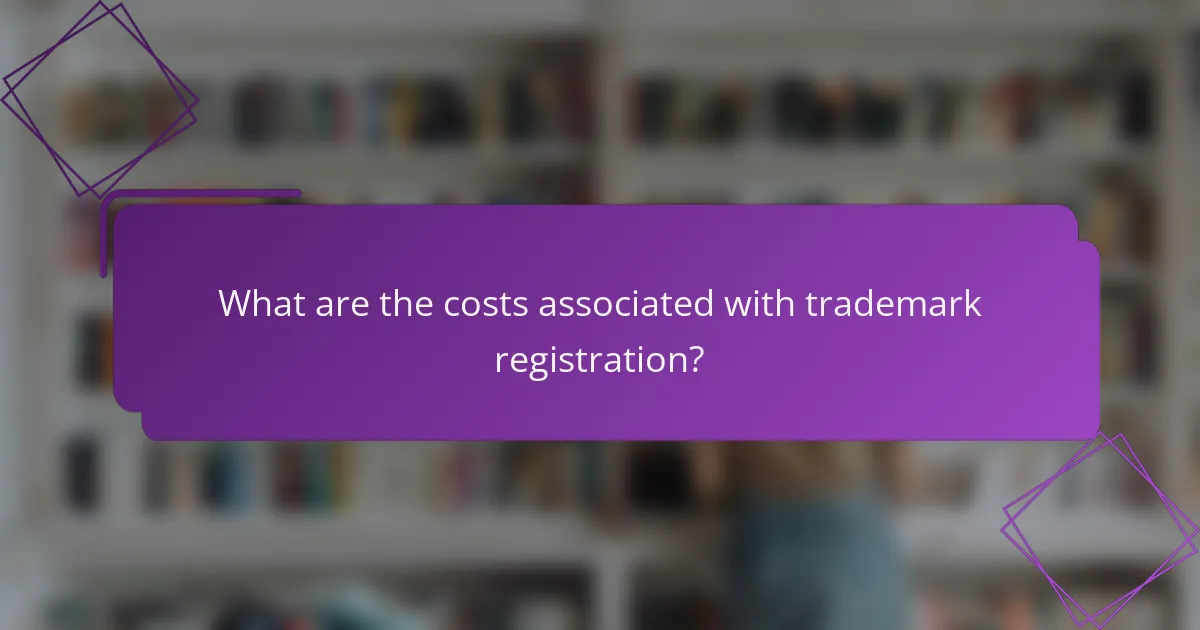
What are the costs associated with trademark registration?
The costs associated with trademark registration can vary significantly based on several factors, including the jurisdiction and the complexity of the application. Generally, applicants should prepare for both filing fees and potential legal fees when seeking trademark protection.
Filing fees for trademark applications
Filing fees for trademark applications typically range from a few hundred to over a thousand dollars, depending on the country and the number of classes of goods or services included in the application. In the United States, for example, the basic filing fee can start around $250 per class if filed electronically.
It’s important to consider that additional costs may arise if the application requires amendments or if the trademark is opposed during the registration process. Applicants should budget for these potential expenses to avoid surprises.
Legal fees for trademark services
Legal fees for trademark services can vary widely, often ranging from several hundred to several thousand dollars. Hiring an attorney to assist with the application process can help ensure that the application is completed correctly and increases the likelihood of successful registration.
Common legal services include conducting trademark searches, preparing and filing applications, and responding to office actions. Authors should weigh the benefits of professional assistance against their budget, as DIY applications may save money but could lead to costly mistakes.
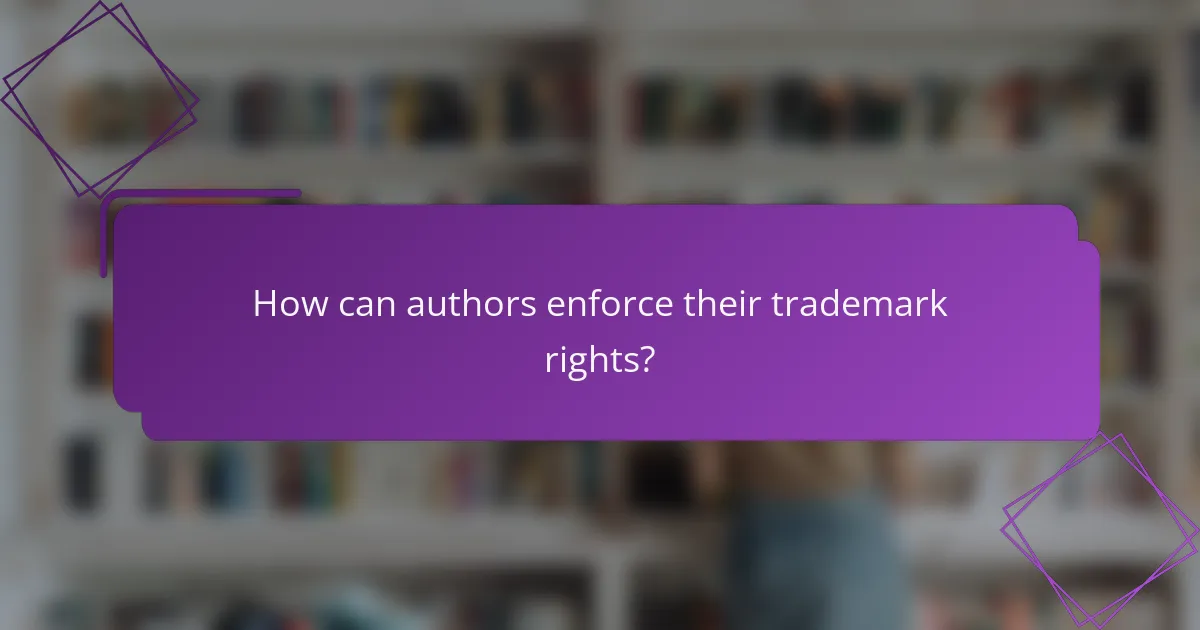
How can authors enforce their trademark rights?
Authors can enforce their trademark rights through various legal mechanisms, primarily by sending cease and desist letters and filing lawsuits for infringement. These actions help protect their brand identity and prevent unauthorized use of their trademarks.
Sending cease and desist letters
Cease and desist letters are formal requests sent to individuals or entities that are infringing on an author’s trademark rights. These letters typically outline the infringement, demand that the infringing party stop their activities, and may include a deadline for compliance.
When drafting a cease and desist letter, it is crucial to be clear and concise. Include specific details about the trademark, the nature of the infringement, and the potential consequences of non-compliance. This approach can often resolve disputes without the need for litigation.
Filing lawsuits for infringement
If a cease and desist letter does not result in compliance, authors may need to file a lawsuit for trademark infringement. This legal action can seek remedies such as injunctions to stop the infringing activities and monetary damages for losses incurred.
Before proceeding with a lawsuit, authors should consider the costs and time involved, as litigation can be lengthy and expensive. Weighing the potential benefits against these factors is essential. In some cases, alternative dispute resolution methods, like mediation, may be more effective and less costly.
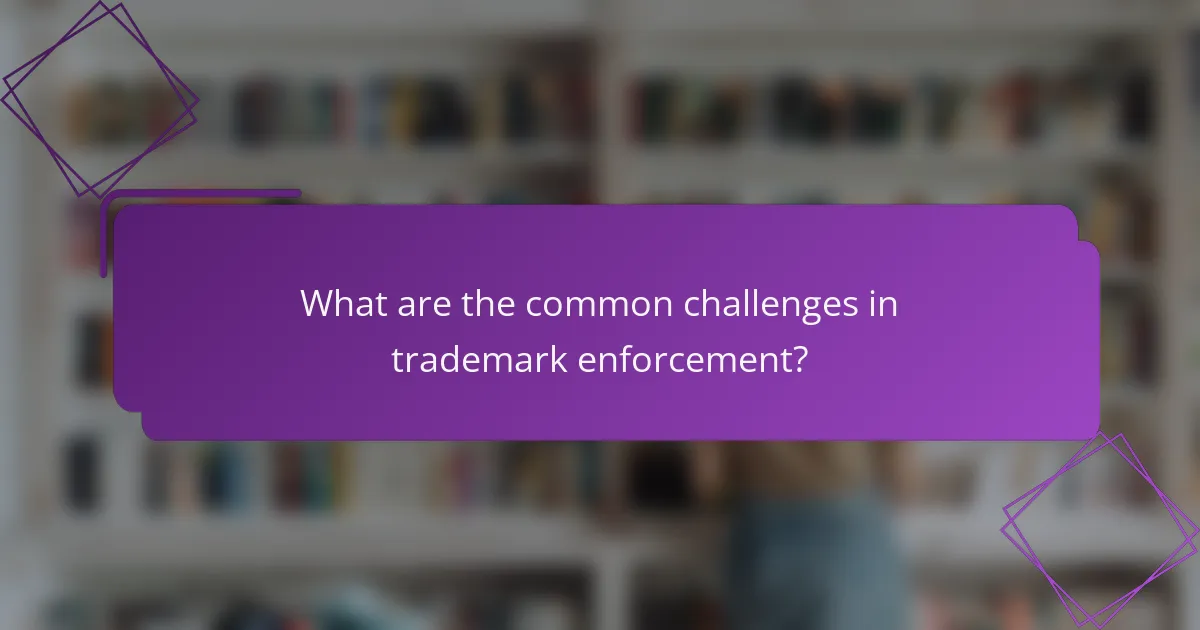
What are the common challenges in trademark enforcement?
Common challenges in trademark enforcement include proving likelihood of confusion among consumers and dealing with counterfeiting. These issues can complicate the protection of intellectual property and require strategic approaches to resolve effectively.
Proving likelihood of confusion
Proving likelihood of confusion is essential for trademark enforcement, as it establishes that consumers may mistakenly believe that two brands are related. Factors considered include the similarity of the marks, the relatedness of the goods or services, and the channels of trade.
To strengthen your case, gather evidence such as consumer surveys, expert testimony, and examples of actual confusion. Courts often look for clear indicators, so ensure your documentation is thorough and well-organized.
Dealing with counterfeiting
Counterfeiting poses a significant threat to trademark owners, as it involves unauthorized use of a trademark on fake goods. This not only dilutes brand value but can also mislead consumers, leading to potential legal ramifications.
To combat counterfeiting, consider implementing a multi-faceted strategy that includes monitoring online marketplaces, collaborating with law enforcement, and educating consumers about authentic products. Regularly review your trademark registrations to ensure they are up-to-date and enforceable.

What are the benefits of trademark registration for authors?
Trademark registration offers authors significant advantages, including legal recognition of ownership and enhanced protection against unauthorized use of their work. By securing a trademark, authors can safeguard their brand identity and prevent others from capitalizing on their reputation.
Legal presumption of ownership
When authors register a trademark, they gain a legal presumption of ownership, which simplifies the process of proving their rights in case of disputes. This presumption can be crucial in legal proceedings, as it shifts the burden of proof to the alleged infringer, making it easier for authors to defend their trademarks.
Additionally, registered trademarks are listed in official databases, providing public notice of ownership. This visibility can deter potential infringers who may be less likely to use a trademark that is already protected.
Enhanced protection against infringement
Trademark registration provides authors with stronger legal tools to combat infringement. Registered trademarks allow authors to take legal action against unauthorized use more effectively, including the ability to seek damages and attorney fees in court. This protection extends to similar goods or services, preventing others from creating confusion in the marketplace.
Moreover, registered trademarks can be enforced at the federal level, offering broader protection than unregistered marks, which are typically limited to the geographic area where they are used. Authors should consider monitoring their trademarks actively to identify potential infringements early and take appropriate action.

How do international trademark laws affect authors?
International trademark laws significantly impact authors by providing a framework for protecting their creative works across borders. These laws help authors secure their brand identity and prevent unauthorized use of their trademarks in various jurisdictions.
Understanding the Madrid Protocol
The Madrid Protocol is an international treaty that simplifies the process of registering trademarks in multiple countries. Authors can file a single application in their home country, which then allows them to seek protection in over 120 member countries.
To utilize the Madrid Protocol, authors must first secure a trademark in their home country. This initial registration serves as the basis for international applications, making it essential to ensure that the domestic trademark is robust and properly filed.
When applying through the Madrid Protocol, authors should be aware of the specific requirements and potential costs associated with each member country. Fees can vary significantly, and understanding these differences can help authors budget effectively for their trademark protection strategy.
